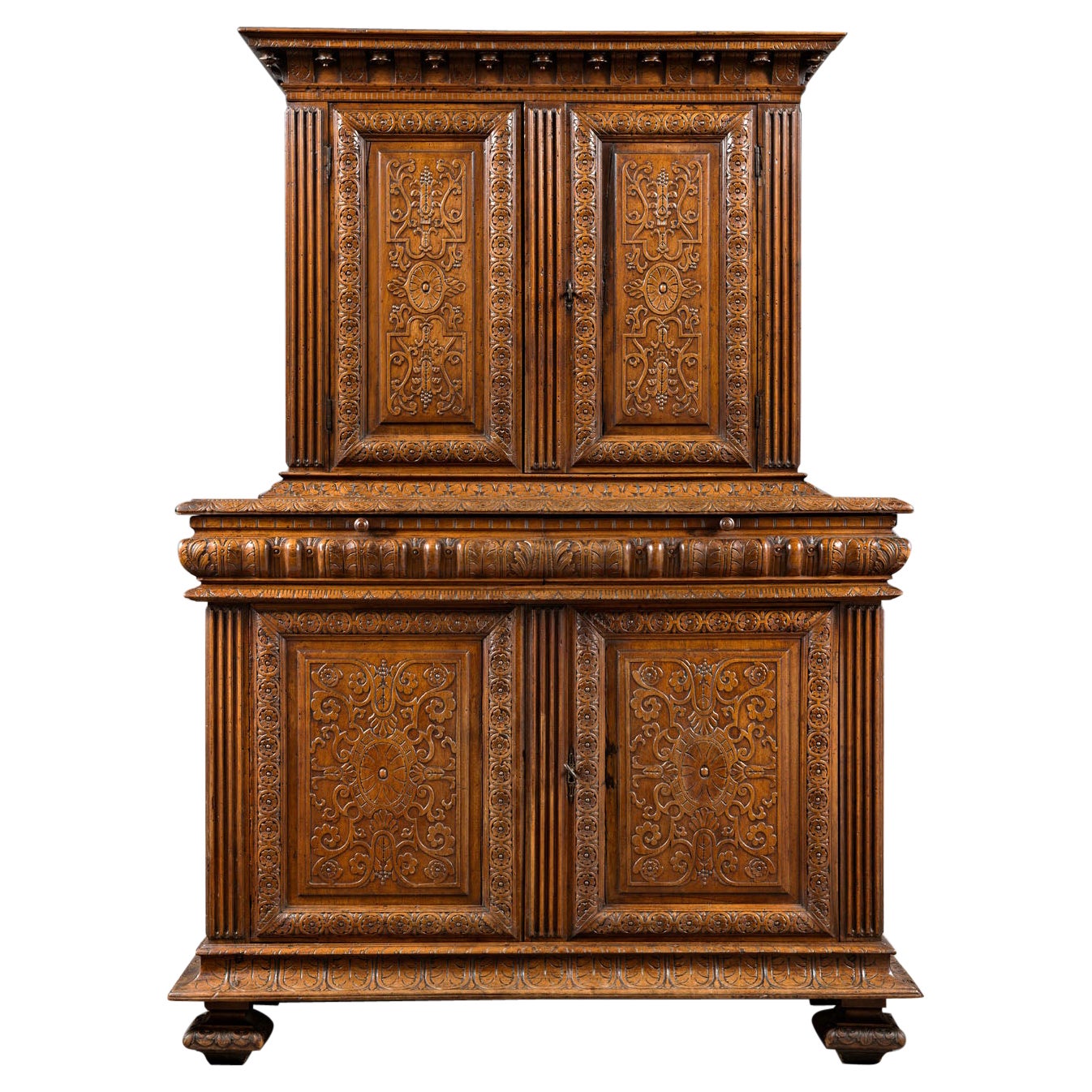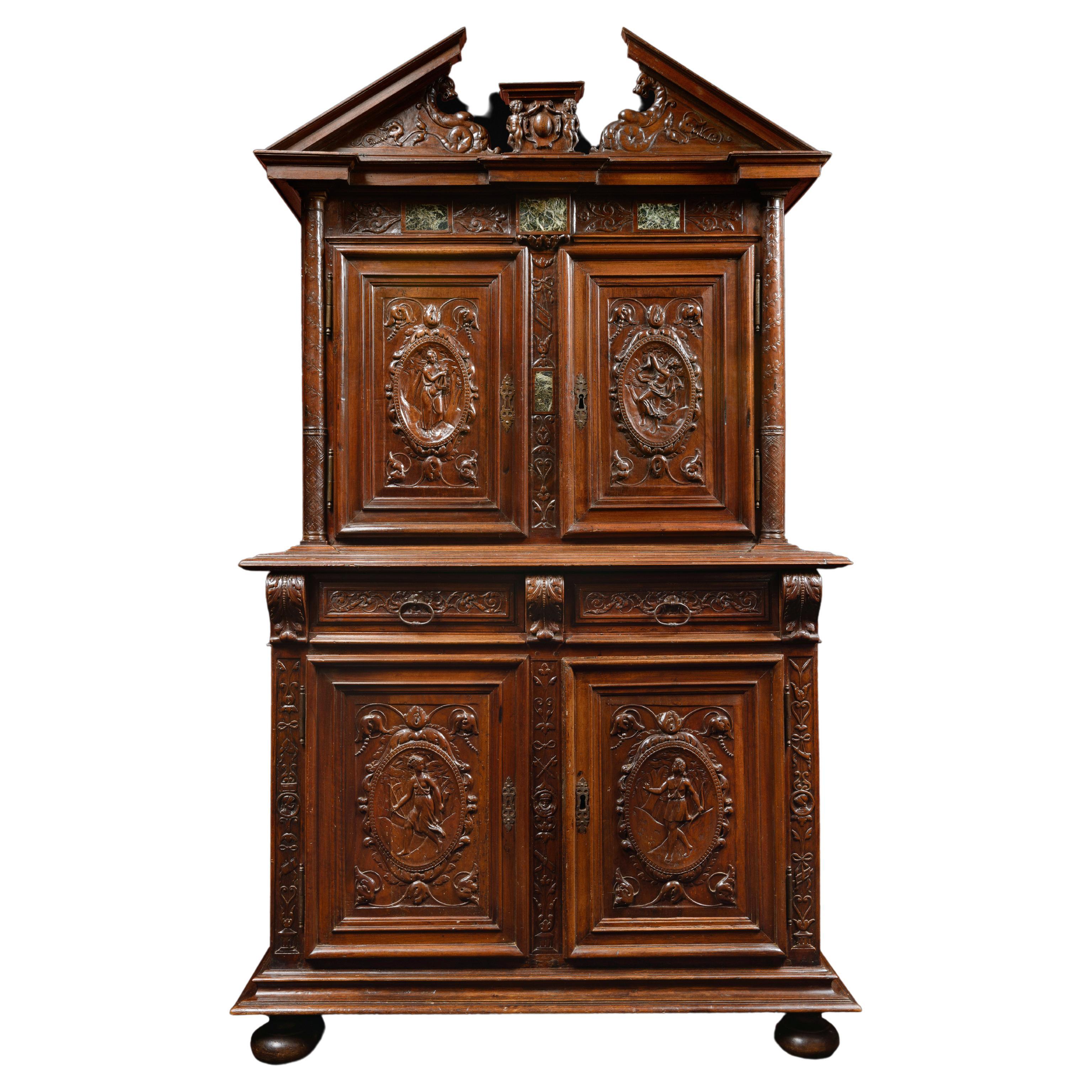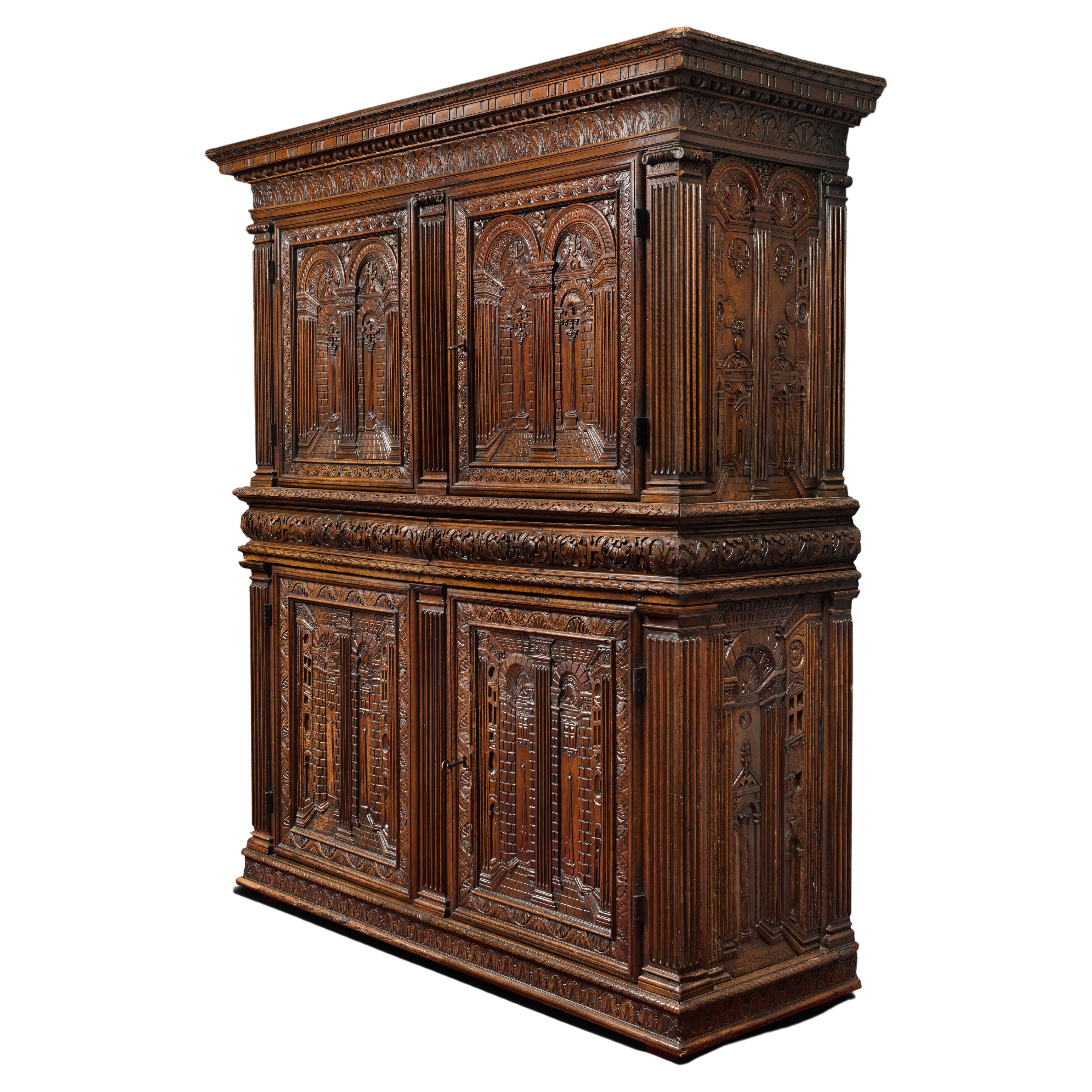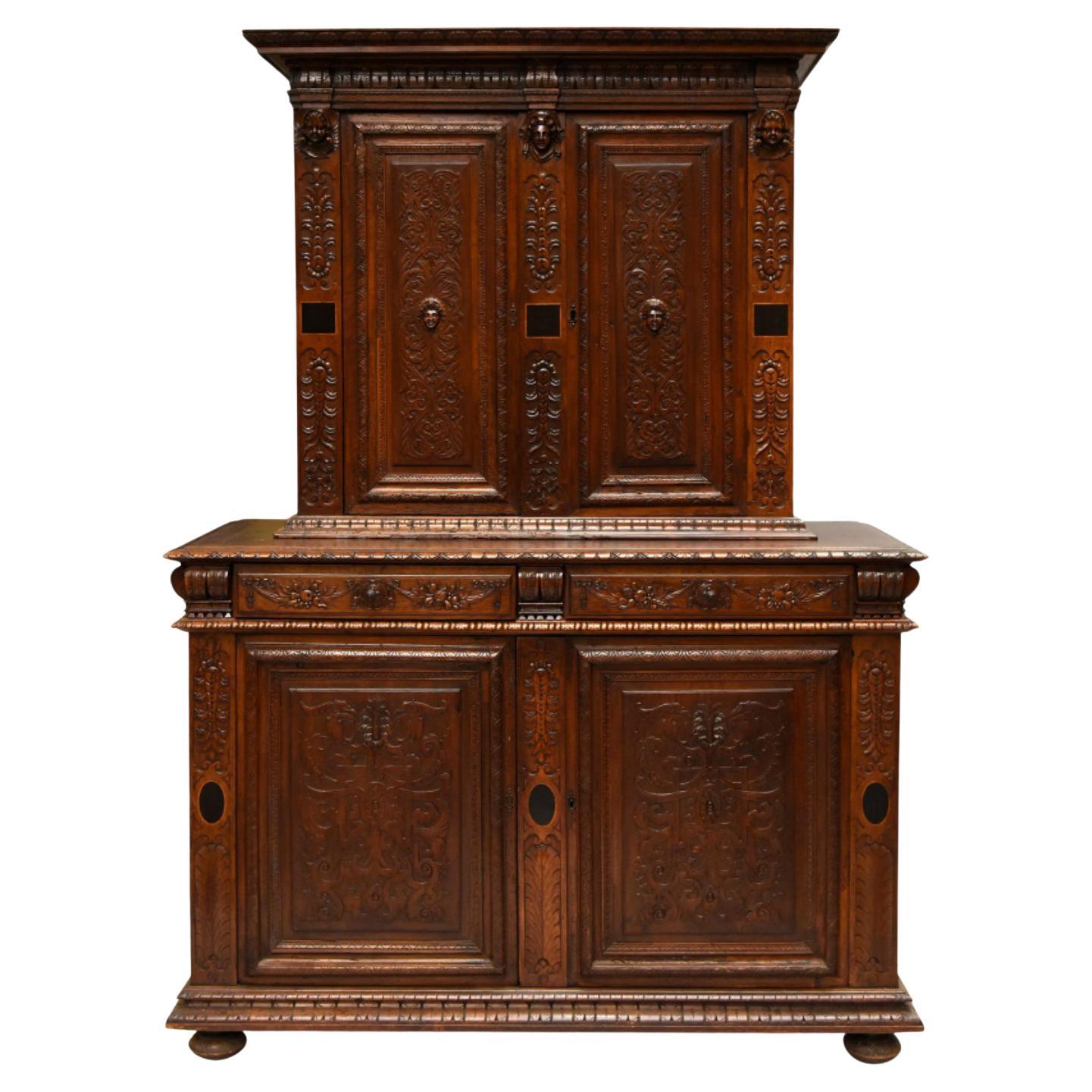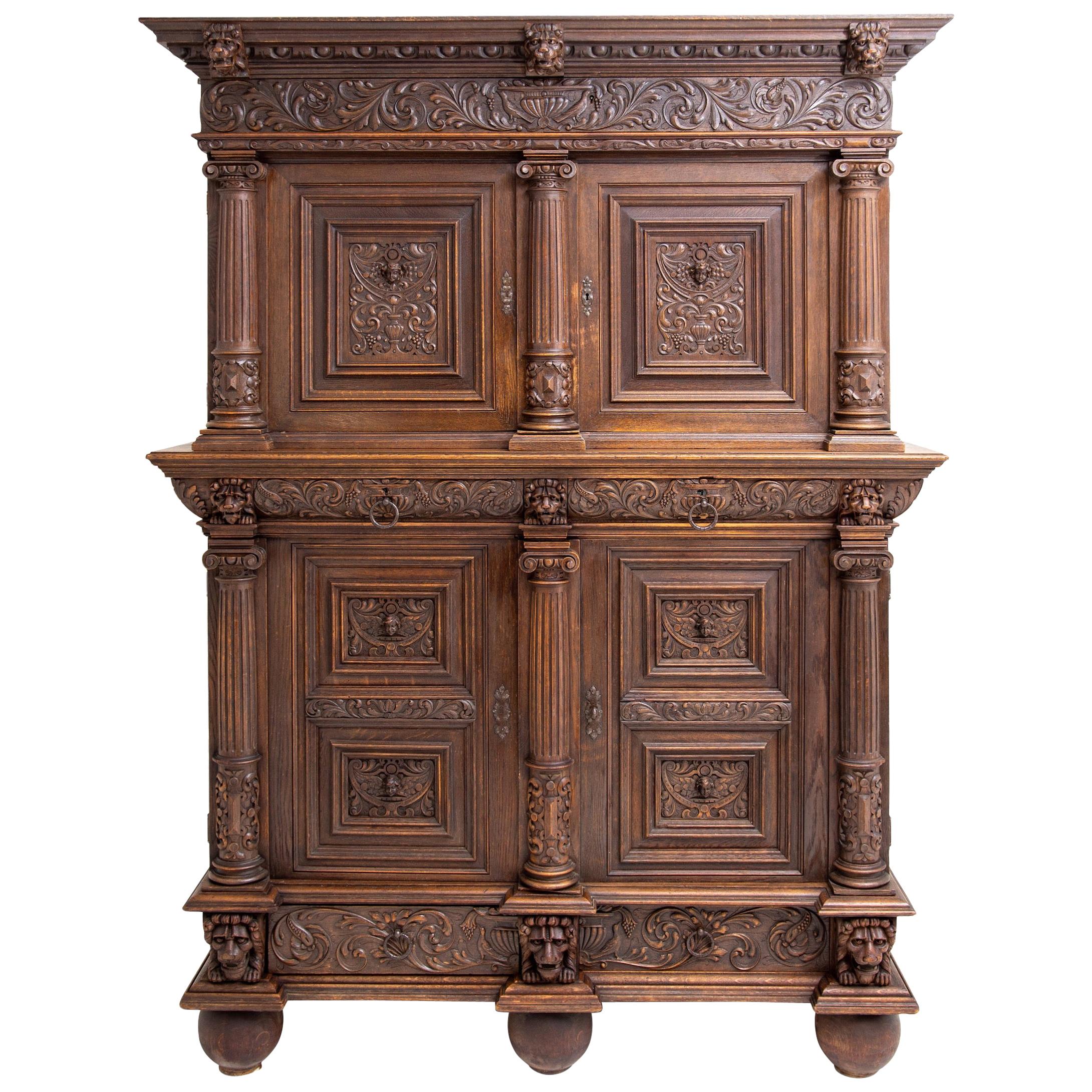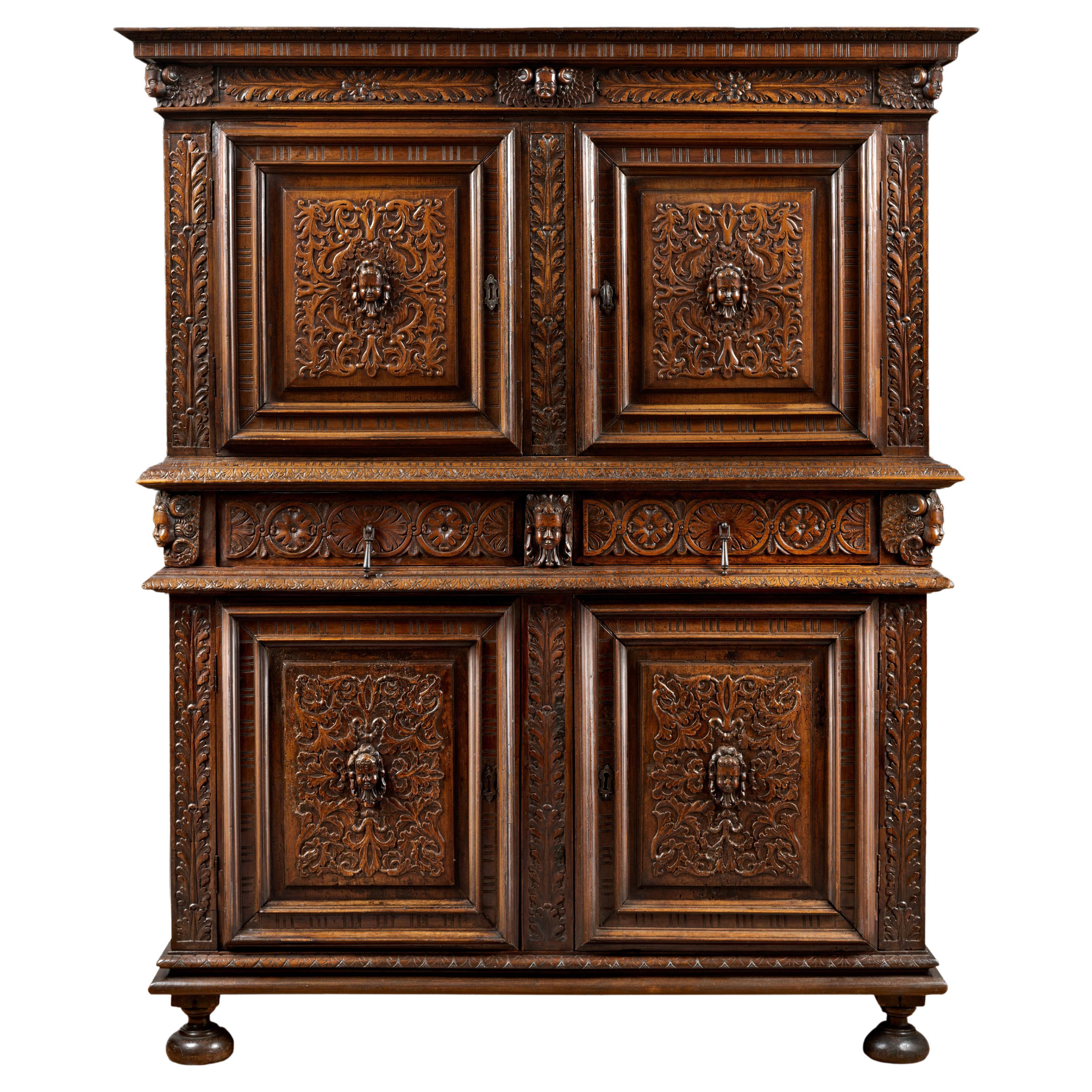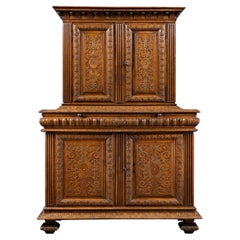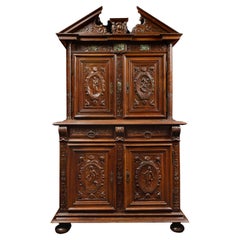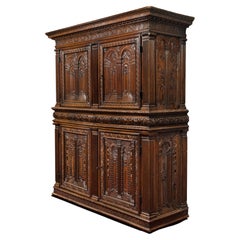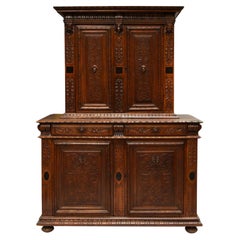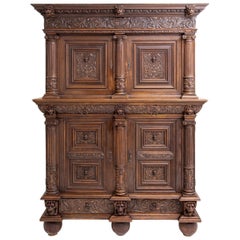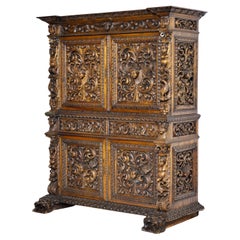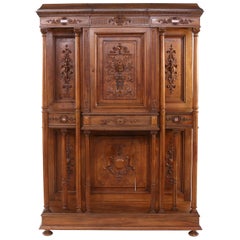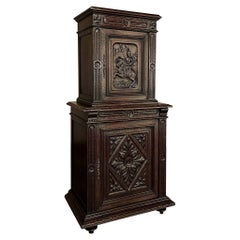Items Similar to Small Cabinet by l'Ecole de Fontainebleau Incrusted with Marble Tablets
Want more images or videos?
Request additional images or videos from the seller
1 of 13
Small Cabinet by l'Ecole de Fontainebleau Incrusted with Marble Tablets
$33,281.55
£24,784.37
€28,000
CA$45,949.68
A$50,942.01
CHF 26,772.02
MX$623,446.68
NOK 334,355.25
SEK 313,825.85
DKK 213,182.67
About the Item
Small cabinet by L’ecole De Fontainebleau Incrusted with marble tablets
Origin : VAL-DE-LOIRE, France
Period : 16th century
Measures: Height : 170 cm
Width : 110cm
Depth : 50cm
Blond walnut wood
Good state of conservation
Thanks to Francois Ier’s blessing, France welcomed italian artists- Le Rosso around 1530, Le Primatice aroud 1532 ans the architects Serlio ans Vignole, around 1541.
Therefore, french artists got inspired by this art, which allowed a revitalization of french art.
Inpacting mostly furniture’s art, shapes are evoluating inspired from the architecture of greco-romano’inspired buildings.
Those workshops are directly inspired from bellifontaine’s art. They use incrustations with marble tablets, japs or porphyry, using different geometrical shapes, sometimes associated with bas-reliefs sculpted panels.
This cabinet stands on feet looking like flattened balls. It opens with four leaves, five drawers from the front and three drawers on the inside.
The bottom part rests on a simple molded base. Each of the uprights and mantelpieces is inlaid with diamond cut marble and a rectangular table of green marble veined with white. They frame the two leaves, made up of three molded frames assembled with mitre cuts.
In between the top and the bottom parts, two drawers are separated by consoles soberly decorated with a blackened wood button and under which is also applied a long blackened wood drop.
The upper part has in its lower part, a large drawer framed by two tinier one. They all are incrustated with marble tablets, in rectangular and triangular shapes.
On those jumps are four doric colomns, with a curved and stretched fur. They frame by pairs the leaves of the upper part.
This cabinet is finished by an entablature alterning console and marble plates.
The furniture’s interior is covered with yellow silk stretched with studded braids.
This cabinet associates purity and harmony. Its purified’ structure and elegant proportions adopt all the rigor of the architecture. Its decoration of inlays of marble tables and blackened wood is, as for it of a big elegance conferring on the piece of furniture, an infinite refinement.
It makes it a really interesting and « bellifontaine » piece of art.
- Dimensions:Height: 66.93 in (170 cm)Width: 43.31 in (110 cm)Depth: 19.69 in (50 cm)
- Style:Renaissance (Of the Period)
- Materials and Techniques:
- Period:
- Date of Manufacture:16th Century
- Condition:Repaired. Wear consistent with age and use.
- Seller Location:Saint-Ouen, FR
- Reference Number:1stDibs: LU3115330449482
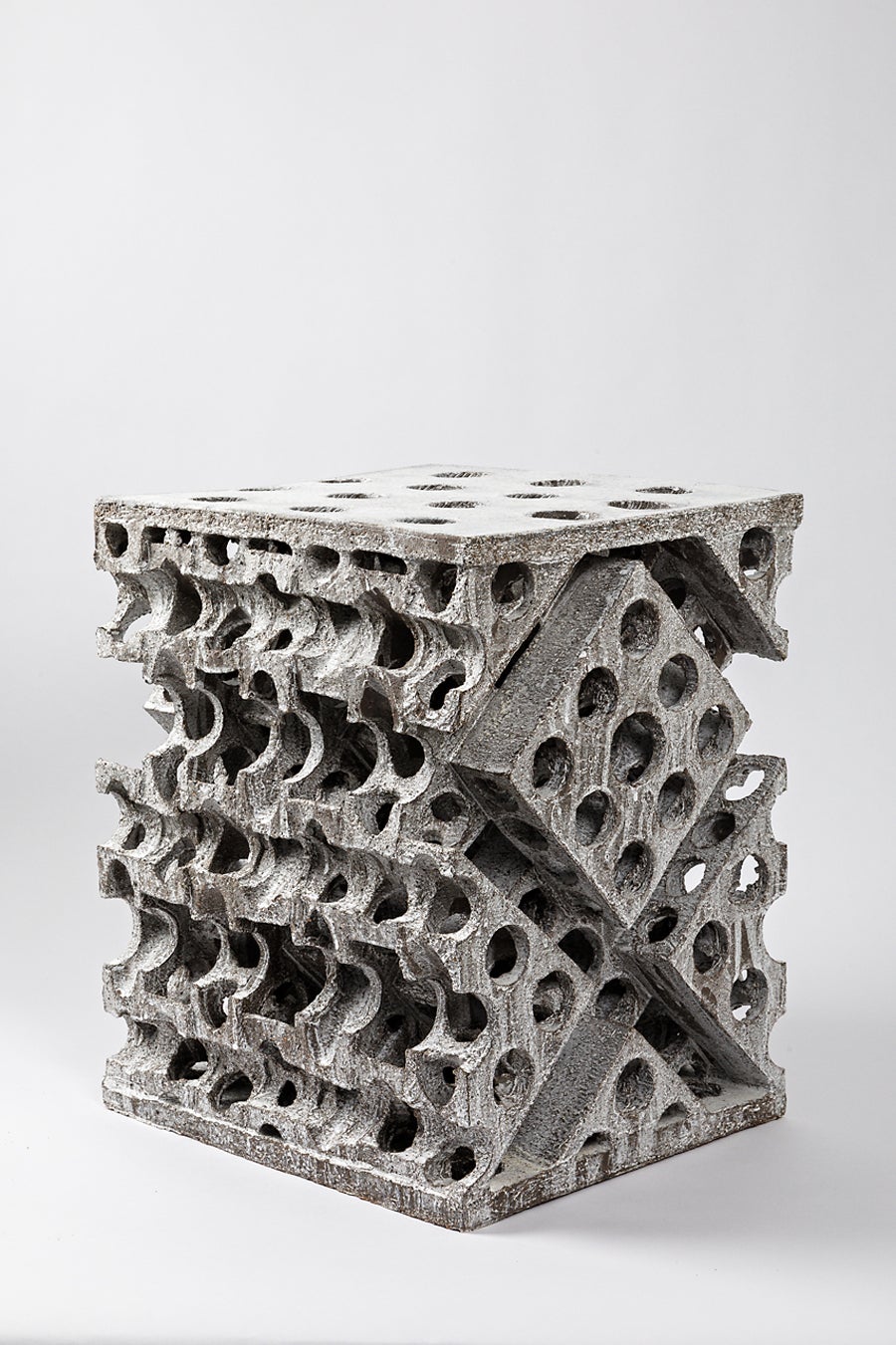
About the Seller
5.0
Vetted Professional Seller
Every seller passes strict standards for authenticity and reliability
Established in 2016
1stDibs seller since 2017
193 sales on 1stDibs
Typical response time: 2 hours
- ShippingRetrieving quote...Shipping from: Saint-Ouen, France
- Return Policy
Authenticity Guarantee
In the unlikely event there’s an issue with an item’s authenticity, contact us within 1 year for a full refund. DetailsMoney-Back Guarantee
If your item is not as described, is damaged in transit, or does not arrive, contact us within 7 days for a full refund. Details24-Hour Cancellation
You have a 24-hour grace period in which to reconsider your purchase, with no questions asked.Vetted Professional Sellers
Our world-class sellers must adhere to strict standards for service and quality, maintaining the integrity of our listings.Price-Match Guarantee
If you find that a seller listed the same item for a lower price elsewhere, we’ll match it.Trusted Global Delivery
Our best-in-class carrier network provides specialized shipping options worldwide, including custom delivery.More From This Seller
View AllExceptional Renaissance Cabinet from Lyon
Located in Saint-Ouen, FR
Exceptional Renaissance Cabinet from Lyon
Origin: Lyon, France
Period: 1540-1580, Second French Renaissance
Measures: Height: 188 cm
Length: 132 cm
...
Category
Antique 16th Century Cabinets
Materials
Walnut
16th Century French Walnut Cabinet with Marble Inlays
Located in Saint-Ouen, FR
On the left post of the lower body, is written the date 1596 in a cartouche
This cabinet has two bodies. The upper part, set back, is moulded and carved. At the bottom, the cabine...
Category
Antique 16th Century French Renaissance Cabinets
Materials
Walnut
Important Renaissance Cabinet from Lyon 'France' with a Decor of Perspectives
Located in Saint-Ouen, FR
As soon as 1540 France's second Renaissance is in the making, intimately linked to the rediscovery of the Antique world. The development of the printing and engraving industry allows the spread of artworks and models in many cities and countries. The Italian influence can be perceived in every artistic field. While the French king entrust the most talented Italian artists with major projects such as Il Rosso or Primaticcio in Fontainebleau, French artists also travel to Italy to form themselves to this new style. In Italy they get acquainted with the work of Leo Battista Alberti the first to theorize perspective (De Pictura, 1435-36) and architecture (De re oedificatoria, 1541). Those two publications would have a revolutionary impact on arts.
Furniture is marked by the work of the most famous Italian architects of the time as well as French architects. Indeed Philibert de l'Orme competes with Alberti and by the end of his life publishes several treaties including one devoted to a theory of architecture (1567). Unfortunately he would not live to complete the second volume. In this treaty he expresses his interest for mathematical norms applied to architecture, copied from the Antique. His journeys in Italy allowed him to accumulate the most sophisticated references. Jean Bullant, another architect of great talent also theorizes his practice. He establishes rules characterizing Greco-Roman art staying faithful to Vitruvius.
Following this new inspiration the structure of furniture evolves. From then on appear columns, capitals, cornices, friezes and architraves. The ornamentation uses this inspiration as well with egg-and-dart, palm leaf and rose adorning the most beautiful pieces.
In Lyon, crossroad where meet merchants from everywhere those new experiments are welcomed. Lyon florishing printing industry allows the spreading of models and treaties essential to the artist's work. Thus the first publication of Vitruvius' De Architectura in France would be printed in Lyon in 1532.
Artists from Lyon rediscover and familiarize themselves with the Antique knowledge very early. They adopt those new ideas and use them in their own creations. Lyon cabinet-makers re interpret Antique architecture and Italian Renaissance palaces to give their pieces a pure and harmonious architectural structure. Grooved pilasters are particularly favored. They are topped by capitals of diverse orders always respecting the sequencing with simpler ones for the lower levels and the richest ones on the higher levels. As for the ornamentation, one of the great distinctiveness of Lyon workshops remains the architectural perspective illusions, drawing inspiration from Tuscany.
True masterpiece of the Second French Renaissance this important cabinet illustrates Lyon workshops' taste for fine Italian architecture inspired by Antiquity. An architectural perspective of great quality is treated in symmetry on each panel.
This two-bodied cabinet without recess stands on four rectangular feet. The base comprises a molding, a palm leaf frieze and is bordered by a braid.
The lower body is divided by three grooved pilasters with Tuscan capitals framing two door-leaves. The two panels are encircled by a moudled frame with palm leaves. They are finely carved with a decor of fantasized architecture depicting an Italian Renaissance palace erected symmetrically on each side of a grooved pilaster. On the ground floor a door opens through a stilted arch while the stories are opened with mullioned windows, dormers and occuli. Two large pegged-boss cladded pillars support the entablature enriched by a palm leaf frieze upon which stands an arch whose coffered intrados is centred by a rose. Behind this arch a pyramid appears, standing in front of a second facade with a window topped by a broken curvilinear pediment under a cul-de-four with a shell.
The checker flooring gives depth to the low-reliefs creating vanishing points structuring the panels and guiding the eye of the observer.
A thin laurel braid highlights the belt of the cabinet where are located two drawers. Their facades are adorned by palm leaves in hoops.
The upper body is encircled with palm leaves. The same ternary division as in the lower body appears. However, the pilasters are topped by Ionic capitals with volutes and egg-and-dart. The door-leaves are framed with flowers. On the panels the artist has designed another architectural decor. On the foreground open two arches on top of grooved pilasters with rectangular capitals adorned with palm leaves. The arches are enriched with braids and the coffered intrados bears a decor of roses. The spandrels also bear a flower decor. In the background another arcature hosts a fluted grooved column topped with double basket acanthus capital, characteristic of Corinthian order. The triangular pediment is interrupted by a choux bourguignon.
A large cornice crowns the cabinet. It stands on pilasters and forms an entablature comprising a palm leaf frieze and an egg-and-dart, triglyph and palm leaf cornice.
The cabinet's sides have also been carefully considered. The lower body's panels are enriched with an arch rising above a broken pediment portico hosting a twisted column. Flowers garnish the spandrels. An architectural facade completes the decor. The upper body's panels present two arches supported by a facade opened with dormers and mullioned windows as well as cartouches (one bears the inscription 1580 dating the cabinet) suggesting the interior of an Italian Renaissance palace, confirmed by the chandeliers. The flooring leads our gaze to a second arch with a broken curvilinear pediment where stands a flower vase. This arch opens onto a perspective of another facade along a road.
Inside the cabinet, on the lower body door-leaves appear two designs. On the right door is depicted a Crucifixion. Saint Mary and Saint John flank the Christ on the cross. In the bottom part is inscribed « Dure uiator abis nihil haec spectacula curas / Pendenti cum sis unica cura Deo. / Tota suo moriente dolet natura Magistro. / Nil qui solus eras caussa dolenda doles. ». The signature [Christoff Swartz Monachiensis pinx[it] / Ioa[nnes] Sadeler sculp[it]] tells us it was made by Johan Sadeler I (1550-1600) after Christoph Schwartz (1548-1592). This engraving belongs to an ensemble depicting the Passion of Christ Johan Sadeler executed in 1589 after an altar piece painted by Christoph Schwartz for the private chapel of Renée of Loraine, wife of Duke William V of Bavaria. This altar piece made of nine copper panels has been destroyed during the 19th century. The Crucifixion panel once in the centre of the altar piece is the only one that survived and is today kept in Munich's Alte Pinakothek.
On the left door appears Saint Francis receiving the stigmata. The inscription says : « Signastidomine Servum Tuum. Franciscum. Signis Redemptionis Nostrae ».
This Renaissance cabinet with an architectural decor appearing as much in the structure faithful to Antique rules...
Category
Antique 16th Century European Renaissance Cabinets
Materials
Walnut
Renaissance Cabinet form Lyon 'France'
Located in Saint-Ouen, FR
Condition : Partly dating from the Renaissance. The backs and the drawer’s insides have been re-done.
Historical background
The 16th century is a prosperous period for Lyon...
Category
Antique 16th Century French Renaissance Cabinets
Materials
Walnut
Small Renaissance Cabinet from Lyon
Located in Saint-Ouen, FR
Small renaissance cabinet from Lyon.
ORIGIN: FRANCE, SCHOOL OF LYON
PERIOD: 16th CENTURY
Height:151cm
Depth: 120cm
Length: 54cm
Walnut ...
Category
Antique 16th Century Cabinets
Materials
Walnut
French Renaissance Cabinet with Perspectives
Located in Saint-Ouen, FR
This Renaissance Cabinet reveals the great mastery of the Lyon workshops which are at the origin of its realization. Sculptors and wood-carvers worked here in symbiosis to express an...
Category
Antique 16th Century French Renaissance Cabinets
Materials
Walnut
You May Also Like
Neo-Renaissance Cabinet, Late 19th Century
Located in Greding, DE
A four-door cabinet in Renaissance style standing on ball feet with lion's head mascarons and half-columns with volute capitals. The doors with panels and vine decoration are separat...
Category
Antique 19th Century German Renaissance Revival Cabinets
Materials
Wood
RENAISSANCE TWO BODY CABINET 19th Century
Located in Madrid, ES
RENAISSANCE TWO BODY CABINET 19th Century
In oak wood
Upper part with two profusely carved doors.
Lower part with two drawers and two doors.
Decorated with plant motifs, zoomorphic ...
Category
Antique 19th Century Portuguese Baroque Cabinets
Materials
Wood
$8,843 Sale Price
20% Off
19th Century French Renaissance Revival Display Cabinet
Located in Tarry Town, NY
Early 19th century French renaissance revival hand carved walnut with marble inserted reserve display wall cabinet. The cabine...
Category
Antique 1810s French Renaissance Revival Cabinets
Materials
Marble
19th Century French Renaissance Two-Tiered Cabinet
Located in Dallas, TX
19th Century French Renaissance Two-Tiered Cabinet will make a handsome addition to your masculine decor. Hand-crafted from solid oak, it features a ne...
Category
Antique 1890s French Renaissance Revival Cabinets
Materials
Brass
19th Century Country French Liegoise Confiturer ~ Cabinet
Located in Dallas, TX
19th Century Country French Liegoise Confiturer ~ Cabinet was hand-crafted from dense, old-growth indigenous white oak by the master artisans of Liege. The storied region has centur...
Category
Antique 1870s Belgian Louis XIV Cabinets
Materials
Brass
Figural Renaissance cabinet, France, around 1870.
Located in Chorzów, PL
Figural Renaissance cabinet, France, around 1870.
Very good condition.
Wood: walnut
dimensions: width 131 cm x height 175 cm x depth 52 cm
Category
Antique 1870s French Renaissance Cabinets
Materials
Walnut
More Ways To Browse
Small French Storage Cabinet
Silk Stretched
16th Century Plate
Small Marble Cabinet
Drop Drawer Cabinet
Marble Curved Cabinet
Antique Yellow Cabinet
Green Marble Cabinet
Kitchen Cabinets Antique White
Antique Architect Cabinet
Diamond Front Cabinet
Green Antique Kitchen Cabinets
Triangular Cabinet
Console Cabinet Marble Top
Kitchen Table With Marble Top
Marble Relief Decorations
French 16th Table
Studded Cabinet
